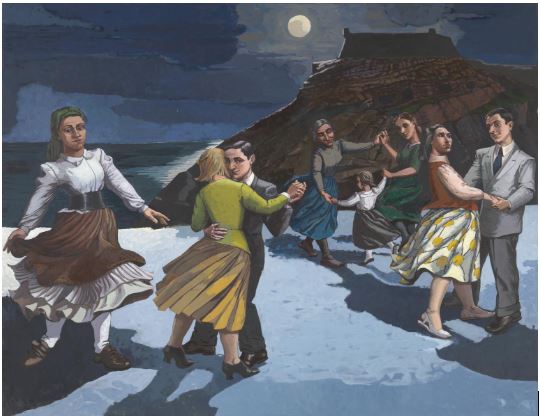“I’d like you to do a painting of people dancing” is something her husband Victor Willing asked her to paint. (CONTENTENGINE, 2020) This led to Rego painting The Dance in 1988.
Paula Rego was a British-Portuguese visual artist who is known for being a pre-eminent artist of the late 20th early 21st century. She grew up under the Fascist dictatorship of Antonio de Oliveira Salazar. Her paintings and prints were known for storytelling based on storybooks. Her paintings would often reflect feminism, and folk-theme from her native country Portugal. From 1952-56, she studied at the Slade School of Fine Art in London. There she met an artist and her future husband Victor Willing. (Tate, Paula Rego)

This is a large acrylic painting The Dance (1988) depicting a scene of people dancing on a moon-lit beach. It features 8 figures of varying ages dancing in the foreground. In the back of the group, there are three figures at different ages, holding hands whilst dancing around in a circle, two dancing couples with one of them appearing to be pregnant, and a woman of left side of the composition stood dancing. In the background, on the right-hand side is a steep, weather-beaten jagged cliff. On top of the cliff is a large refuge, depicted in a silhouette against the deep-blue night sky with inky clouds and a bright full moon lighting up the dancers. Underneath the sky is a calm sea. The painting has a calm but happy atmosphere. The faces looking focused and happy. It has a dreamish, illusive quality with its night-time setting and lengthy shadows cast from the figures. Judging from the clothes, the structured top and full skirts could indicate that the setting of the painting is 1950s. The scene in this painting could represent a memory of folk festivals.
The painting has a few iconographical symbolisms. The subjects are happily dancing under the moonlit night sky. The darkness of this symbolises mystery but not necessarily evil as light can emerge from the moon. Whilst it has meanings of rhythm of time, birth, death, and resurrection. (J.C.Cooper, 1978) Several of the subjects are at different ages with three dancing women at the back, where one of them an adult, middle aged woman, and a young child. With being at different ages and dancing in a circle, this could symbolise the circle of life. (J.C.Cooper, 1978) The ocean gives us the symbolic meaning of endless motion. With the subjects dancing gives a symbolic meaning of creative energy and transformation of space into time. (J.C.Cooper, 1978). Putting all this into the context of the painting The Dance (1988) starts to reveal a story of happiness with a passage of time but also something nefarious is lurking as a cliff is looming over the dancing figures.
When she painted The Dance (1988), she also inserted herself and her husband into the painting. The figure on the left dancing alone is of herself and the male figure is of her husband. She is painted herself alone, when at the time of painting this, her husband died, wanted to represent herself as independent and strong. this can also be interpreted as her way of telling the audience as she is observing the figure in the painting about the different life stages many people would go through in their lives. She chose to dress herself in the painting in Portuguese folk dress. She may have chosen to do this to show her heritage. As her husband was ill in bed at the time of her painting this, she asked her son, Nick to stand in, as Nick at the time looked a lot like Victor Willing. Soon after this he died. This would have been a wonderful way to both represent her husband and to process her grief as she proceeded to finish this painting after Victor Willing’s death. When painting this, she like to pin the paper onto the floor and paint on the floor, rather than the traditional way of painting on an easel. (Tate,2022)
Paula Rego’s The Dance (1988) took her over a period of six months to complete. Her creative process for creating her final paintings always started with drawing as a working practice, as said by Paula Rego “I love doing it, and I love looking at it. Good drawings are more intensely alive than any other art-they are about being alive” (Bradley.F, 2002). She does this so she can find the best way to tell a story through the figures and the way she arranges them, especially when she is stuck and out of ideas. After finishing with her ideas and drawing being happy with it, she then transfers it onto the canvas and paints it. (Bradley.F, 2002)
Bibliography
Bradley.F 2002. Paula Rego, Tate Publication
J.C.Cooper. 1978. An illustrated encyclopedia of traditional symbols. Thames and Hudson
Recommend0 recommendationsPublished in Art History, Student Research, UncategorizedShare this:
- Click to share on Facebook (Opens in new window) Facebook
- Click to share on X (Opens in new window) X
- Click to print (Opens in new window) Print
- Click to email a link to a friend (Opens in new window) Email
- Click to share on LinkedIn (Opens in new window) LinkedIn
- Click to share on Reddit (Opens in new window) Reddit
- Click to share on Pinterest (Opens in new window) Pinterest


Responses